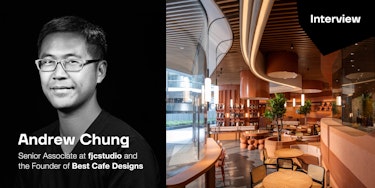Andrew Chung is a Senior Associate at fjcstudio. He is a well rounded design professional with particular interests in design excellence, training and culture and quality systems development and implementation. He has contributed to award-winning projects in the residential, commercial, educational, and public sectors. Andrew is also an experienced architectural photographer and the founder of Best Cafe Designs, a website showcasing unique coffee shop designs from around the world.
We were glad that Andrew shared with us a story about his career path, approach to creative work and new project Best Cafe Designs.
Alina: Hello, Andrew. I'm sure many of your interviews have started with this question, but it's important for our readers to know how it all began. Сan you share your journey at fjcstudio and what initially attracted you to the firm? How has your role evolved over time?
Andrew: I started in 2001 as a graduate. I came as a fresh sponge wanting to learn from any opportunity given. I have grown with the firm, and worked across almost all project phases and building typologies. I have worked on small teams, and large teams on local, interstate and international projects.
Alina: How do you stay inspired and maintain creativity in your design work? Are there any specific rituals or practices you follow?
Andrew: There’s room for creativity in any situation. Any brief is a challenge and an opportunity, and whether there is design autonomy or your working in a team, there are always ways of implementing creative solutions and working on projects within projects.
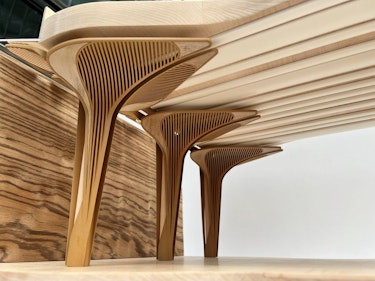
Credit: Courtesy of Infrastructure NSW (The Cutaway, Barrangaroo)
Alina: As an experienced architectural photographer, how do you believe architectural photography enhances the perception and understanding of a design?
Andrew: I learnt photography by following John Gollings on a few shoots. I learnt the importance of framing, vertical alignment and deliberate one point axial photos, or two point perspective. I have been fortunate to photograph great fjcstudio work, but I understand the higher level of photography requires extreme patience and persistence. It involves understanding how materials respond to different lighting conditions, and how spaces get used and are occupied. Photography can be helpful in designing spaces to scenes. It generally results in more balanced, and ordered spaces. There are limitations as well, as some spaces are appreciated from multiple viewpoints.
Alina: What role does creative content play in showcasing architectural projects, and how do you integrate this into your work?
Andrew: Like many practices Fjcstudio considers serious issues of Country, Climate and Community. They are recognised and acknowledged as some of the key drivers, constraints, opportunities and influences that shape our projects and our work. We analyze, design, integrate and review these key themes through the design, documentation and delivery phases of projects.
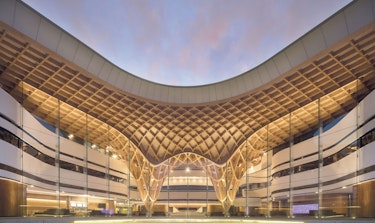
Credit: John Gollings (Bunjil Place, Melbourne)
Alina: How do you think advancements in technology, such as AI and automation, will impact the future of architecture and design?
Andrew:
I sway between early adopter and skeptic. I am willing to try new things, but also revert to yellow trace sketches and markups. Someone taught me early in my career that you can resolve complex design interfaces 3 times faster drawing by hand, than by computer. I often take a hybrid approach, and develop several ways of drawing things.
It’s always risky to comment on something so new, but I think AI and automation will not affect all areas of design.
Alina: What role do you foresee virtual reality playing in the future of architectural design, particularly in terms of client engagement and presentation projects?
Andrew: We have looked at VR for presentations and for drawing. I’m personally looking into 360 cameras at the moment. For design though, I think VR can immerse you into a space, but distract and exaggerate certain elements or features that would be best to analyse objectively outside of the environment.

Credit: John Gollings (Liberty Place 161 Castlereagh Street)
Alina: What inspired you to create Best Cafe Designs, and what values did you aim to incorporate into the project?
Andrew: I’m always tinkering and acquiring new skills. The project grew and evolved organically. I wanted to combine several of my skills in architecture, photography, web design and appreciation of coffee into a new website bestcafedesigns.com It’s come a long way in a short period of time, and was recently ranked in the top 100 architecture blogs and websites to follow at feedspot.
In talking to other architects that work in the cafe design space, I wanted to increase the acknowledgement of designers. I wanted to create a resource that I was happy to share personally and professionally, and its a constantly refining project. In the online space you can pivot and make drastic changes. All knowledge to develop the project is attainable either by learning it yourself, or going onto global talent marketplaces like upwork.
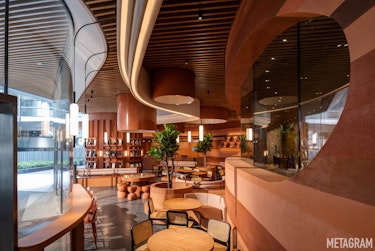
Credit: HK(Metagram) Photography by Steven Ko
Alina: What unique challenges or opportunities do you think designing coffee shops presents compared to other spaces?
Andrew: My main experience is actually designing large scale buildings that are either residential, commercial or public. Coffee shop designs are something that I appreciate more recently. Part of the reason for creating the website was so I could have a resource for designing a cafe for a friend.
Coffee shop design is quite diverse. There are the fixed items like the coffee machine and the front and back kitchen and customer flow. Apart from that there are many ways to use materials and create spaces that are amazing and fun to be in.
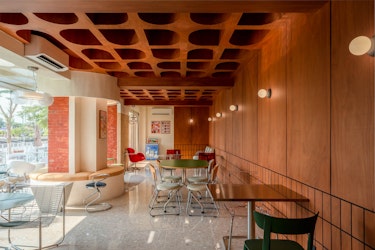
Credit: Thailand (AA+A Architecture) VARP Photography
Alina: What criteria do you use to select cafes to feature on Best Cafe Designs? Could you share some memorable cafe designs or trends featured on the website?
Andrew: Best Cafe Designs has cafes from all continents including Asia, Europe, Africa, America and Oceania. I’m so happy to feature so many creative designs from amazing places. I’m creating a complete repository of best cafe designs including: Modern, Heritage, Greenery, Colourful, Minimalist and Laneway Cafe Designs. If you're an architect that has designed cafes, feel free to contact us for a collaboration.
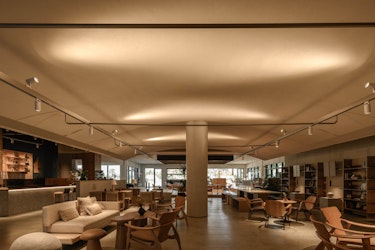
Credit: China (Fun Connection) Photography by Tan Xiaozhong
Alina: Thanks again for taking the time to share your thoughts.
